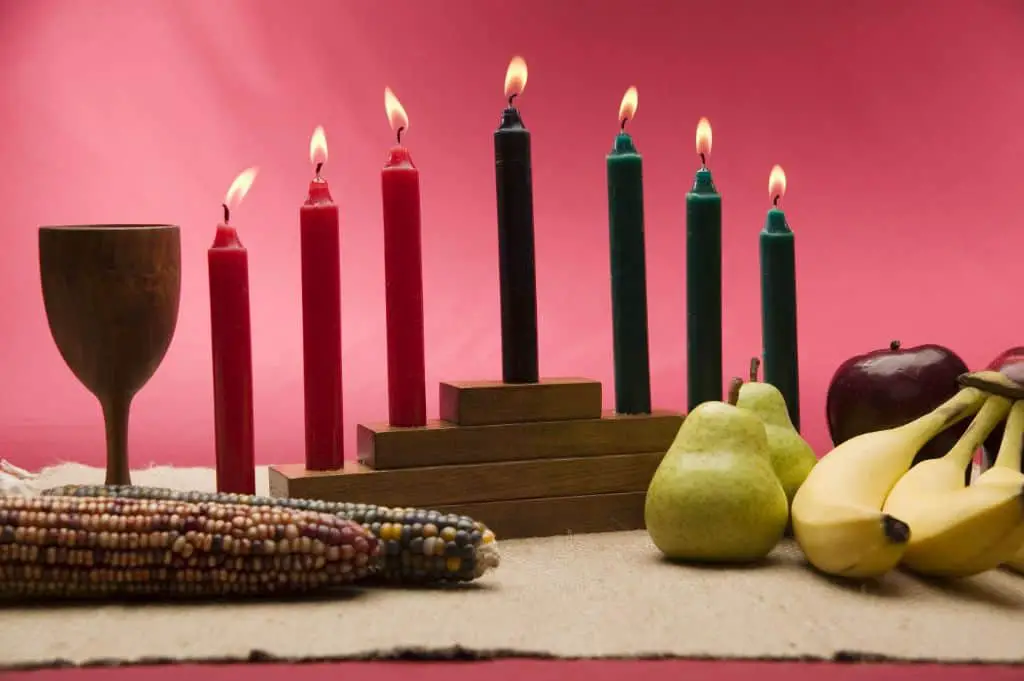Kwanzaa is an annual celebration of African-American culture that takes place from December 26 to January 1 each year. One of the most recognizable symbols of Kwanzaa is the kinara, which holds seven candles that are lit over the seven days of the celebration. Each candle represents one of the seven principles (Nguzo Saba) on which Kwanzaa is based.
The Seven Principles
The seven principles, or Nguzo Saba, are values that reflect African culture and contribute to community building and reinforcement. They serve as guidelines for how to be a good person and live a good life. The seven principles are:
Umoja (Unity)
Umoja means unity in Swahili. Unity refers to togetherness within the family, community, nation, and race. Umoja seeks to promote cooperation and discourage separatism. During Kwanzaa, Umoja is honored to inspire a sense of family within the community.
Kujichagulia (Self-Determination)
Kujichagulia means self-determination in Swahili. To exhibit Kujichagulia is to define, name, create, and speak for oneself. During Kwanzaa, participants commit to defining themselves for themselves and speaking for themselves rather than being defined or spoken for by others.
Ujima (Collective Work and Responsibility)
Ujima means collective work and responsibility in Swahili. Ujima encourages collaboration and building cooperative communities. During Kwanzaa, participants strive to solve community problems together and assist those in need.
Ujamaa (Cooperative Economics)
Ujamaa means cooperative economics in Swahili. Ujamaa focuses on building and maintaining businesses to benefit the community rather than just the individual. During Kwanzaa, participants are encouraged to support black-owned businesses.
Nia (Purpose)
Nia means purpose in Swahili. Nia encourages participants to set personal goals that benefit the community. The focus is on collective vocation to build and develop the community rather than individual success.
Kuumba (Creativity)
Kuumba means creativity in Swahili. Creativity encourages using skills and talents to benefit the community. During Kwanzaa, participants are encouraged to use their creative talents to solve community problems and uplift others.
Imani (Faith)
Imani means faith in Swahili. Faith focuses on believing in people, families, leaders, and the righteousness of the African-American struggle. During Kwanzaa, participants strive to believe in themselves and their ability to succeed and overcome.
The Seven Candles
There is one candle for each of the seven principles, as follows:
| Candle | Principle |
|---|---|
| Black candle | Umoja (Unity) |
| Red candle | Kujichagulia (Self-Determination) |
| Green candle | Ujima (Collective Work and Responsibility) |
| Red candle | Ujamaa (Cooperative Economics) |
| Red candle | Nia (Purpose) |
| Green candle | Kuumba (Creativity) |
| Red candle | Imani (Faith) |
The black candle is placed in the center of the kinara. The three red candles are placed to the left of the black candle, while the three green candles are placed to the right.
Lighting the Candles
The candles are lit each day starting on December 26 and continuing through January 1. One candle is lit on each day in the following order:
| Day | Candle Lit |
|---|---|
| December 26 | Black candle |
| December 27 | Far left red candle |
| December 28 | Far left green candle |
| December 29 | Middle red candle |
| December 30 | Middle green candle |
| December 31 | Far right red candle |
| January 1 | Far right green candle |
On each day, participants discuss the principle associated with the candle being lit. These discussions allow reflection on the meaning of each principle and ways to incorporate it into daily life. The lighting of the candles provides a symbolic way to honor African-American heritage and focus on building community.
Conclusion
The seven candles of the Kwanzaa kinara represent the seven principles that are the foundation of the celebration. Lighting the candles over seven days allows time for contemplation and commitment to upholding these principles year-round. The candles provide symbolic inspiration to strive for unity, self-determination, collaborative work, cooperative economics, purpose, creativity, and faith in the community. These principles reflect values that contribute to individual and collective growth.


